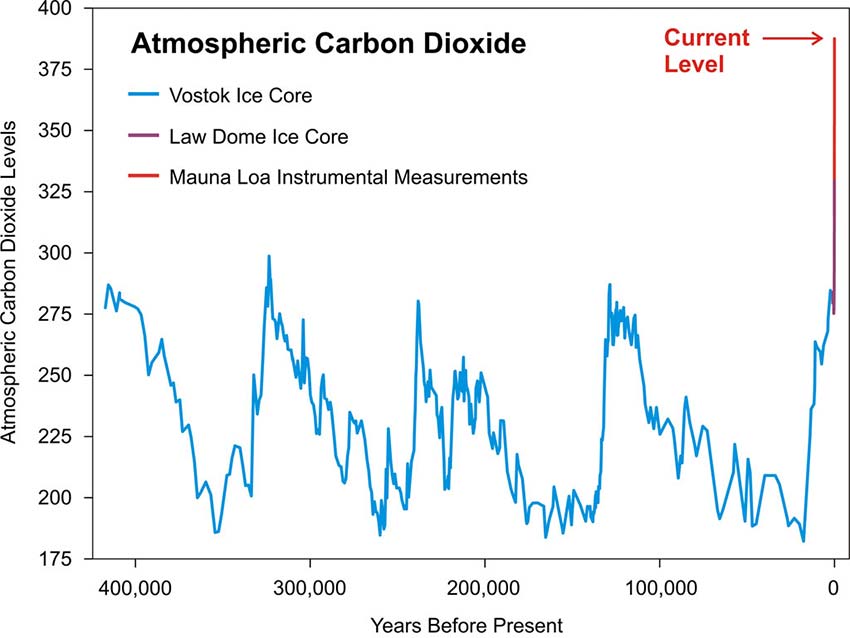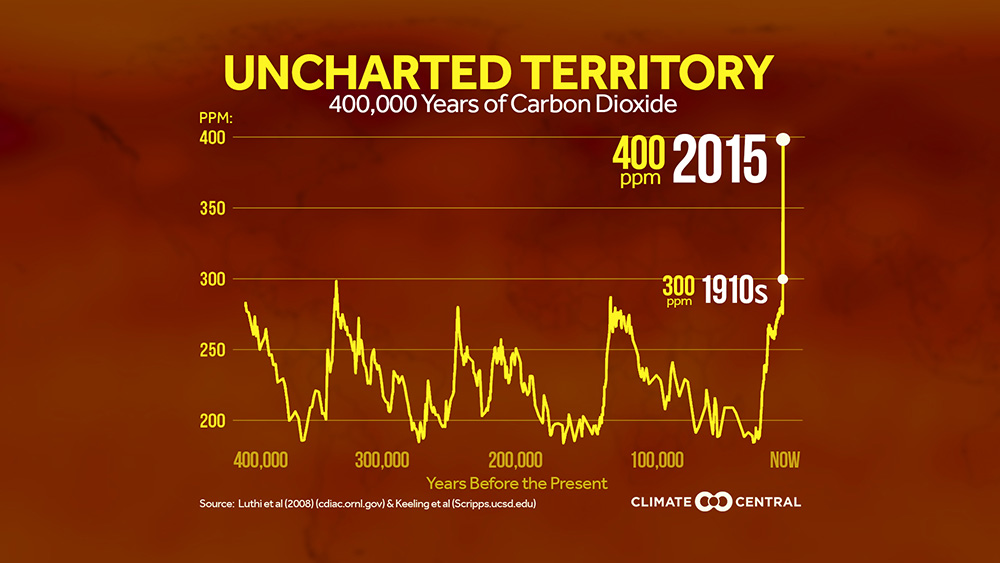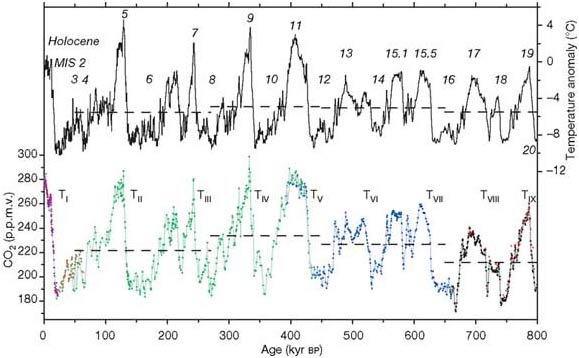
Greenland Ice Core at American Museum of Natural History, New York (image cropped)
Source Image Eden, Janine & Jim | CC BY 2.0
The farther backward you can look,
the farther forward you are likely to see.
~ Winston Churchill
Homo sapiens appeared in our present form about 200,000 years ago. Human civilization emerged about 12,000 years ago. The study of past CO2 levels and climates helps us undersand the conditions in which human societies developed. This 'paleoclimate' information offers important lessons for understanding sustainability and the range of climatic conditions that human societies are known to be suited for.
To understand past climates, ice cores provide a high-resolution record of key climate variables that span the period in which homo sapiens appeared and human civilization developed. Aside from the high-precision CO2 measurements that Charles David Keeling started at the South Pole in 1957 and the Mauna Loa Observatory in 1958, ice cores are the best source of atmospheric CO2 data for the prior 1 million years.
Scientists have been drilling ice sheets and analyzing the ice cores since the 1950s, particularly in Antarctica and Greenland. Areas with accumulating snow turn to ice with air bubbles that preserve samples of the atmosphere from world atmospheres of the past. Scientists are able to analyze the cores to learn about past changes in the concentration of atmospheric gases and the glacial-interglacial cycles for the past million years.
Here, use the CO2 data and graphs to explore changes in the past, from a thousand to a million years before present.
Ice Core Research
NOAA NCEI Ice core data
NOAA NCEI NOAA paleoclimatology ice core datasets
NSIDC Antarctic Glaciological Data Center
EGU 2013 Finding a 1.5 million-year record of earth's climate
Articles
NASA 2005 Paleoclimatology: The Ice Core Record
SkS We've been through climate changes before
1 KYr
-
1,000 Years CO2 Data (papers: 1989-1997)
Three ice cores drilled at Law Dome, East Antarctica from 1987 to 1993 resulted in atmospheric CO2 records from 1006 A.D. to 1978 A.D.
The records extend into recent decades for which instrument measurements of atmospheric CO2 levels occured. This was enabled because of the high rate of snow accumulation at the Law Dome drill sites. Scientists reported that the air enclosed in the three ice cores have unparralleled age resolution.
Uncertainty in the data is 1.2 parts per million (ppm). Pre-industrial CO2 levels range from 275 to 284 ppm. Lower levels occured between 1550 and 1800 A.D. These ice cores show major growth in atmospheric CO2 levels in the industrial period except 1935-1945 A.D. when levels stabilized or decreased slightly.

Source Graph Etheridge et al. (via CDIAC)
Link
CDIAC Historical CO2 records from Law Dome ice cores
CDIAC Data | Etheridget et al. (1998)
CDIAC Graphics
NOAA-NCDC Composite Data | 0 - 800 KYr [Excel]
Reference
D.M. Etheridge, L.P. Steele, R.L. Langenfelds, R.J. Francey, J.-M. Barnola and V.I. Morgan. 1998. Historical CO2 records from the Law Dome DE08, DE08-2, and DSS ice cores. In Trends: A Compendium of Data on Global Change. Carbon Dioxide Information Analysis Center, Oak Ridge National Laboratory, U.S. Department of Energy, Oak Ridge, Tenn., U.S.A.
400 KYr
-
400,000 Years CO2 Data (papers: 1999 to 2005)

Atmospheric CO2 History | 400,000 Years Before Present
Source Graphic SkS CC BY SA 3.0 [Large JPEG]
Alternate Graphic CDIAC | CO2 Record from the Vostok Ice Core (2.3 KYr - 417 KYr B.P.)
Data
CDIAC Vostok | 2.3 KYr - 417 KYr
NOAA-NCDC Composite Data | 0 - 800 KYr [Excel]
0 - 22 KYr | Dome C, Antarctica
Science 2001 Monnin et al. | Atmospheric CO2 concentrations over the Last Glacial Termination [abstract]
22 - 393 KYr | Vostok, Antarctica
J. Geophysical Res. 2001 Pépin et al . | Hemispheric climate forcings deduced from Vostok cores & LLN-2D [.pdf]
Nature 1999 Petit et al. | Climate and atmospheric history, 420,000 years from Vostok ice core [abstract]
Nature 2005 Raynaud et al. | Palaeoclimatology: The record for marine isotopic stage 11 [abstract]
393 - 416 KYr | Dome C, Antarctica
Science 2005 Siegenthaler et al. | Stable C Cycle & Climate Relationship in Late Pleistocene [.pdf]

Source Graphic Climate Central [2015 article] [image downloads]
References
Monnin, E., Indermühle, A., Dällenbach, A., Flückiger, J., Stauffer, B., Stocker, T. F., . . . Barnola, J.-M. (2001). Atmospheric CO2 concentrations over the Last Glacial Termination. Science, 291(5501), 112-114. doi:10.1126/science.291.5501.112
Pépin, L., Raynaud, D., Barnola, J. M., & Loutre, M. F. (2001). Hemispheric roles of climate forcings during glacial-interglacial transitions as deduced from the Vostok record and LLN-2D model experiments. Journal of Geophysical Research, 106(D23), 31885–31892. doi:10.1029/2001JD900117
Petit, J. R., Jouzel, J., Raynaud, D., Barkov, N. I., Barnola, J. M., Basile, I., . . . Stievenard, M. (1999). Climate and atmospheric history of the past 420,000 years from the Vostok ice core, Antarctica. Nature, 399(6735), 429-436. doi:10.1038/20859
Raynaud, D., Barnola, J.-M., Souchez, R., Lorrain, R., Petit, J.-R., Duval, P., & Lipenkov, V. Y. (2005). Palaeoclimatology: The record for marine isotopic stage 11. Nature, 436(7047), 39-40. doi:10.1038/43639b
Siegenthaler, U., Stocker, T. F., Monnin, E., Lüthi, D., Schwander, J., Stauffer, B., . . . Jouzel, J. (2005). Stable carbon cycle-climate relationship during the Late Pleistocene. Science, 310(5752), 1313-1317. doi:10.1126/science.1120130
650 KYr
-
650,000 Years CO2 Data (paper: 2005)

Source Graphic IPCC AR4 2007 [Hi-Rez Image]
Data
NOAA-NCDC Composite Data | 0 - 800 KYr [Excel]
416 - 664 KYr | Dome C, Antarctica
Science 2005 Siegenthaler et al. | Stable C Cycle & Climate Relationship in Late Pleistocene [.pdf]
Reference
Siegenthaler, U., Stocker, T. F., Monnin, E., Lüthi, D., Schwander, J., Stauffer, B., . . . Jouzel, J. (2005). Stable carbon cycle-climate relationship during the Late Pleistocene. Science, 310(5752), 1313-1317. doi:10.1126/science.1120130
800 KYr
-
800,000 Years CO2 Data (paper: 2008)
In 2008, Dieter Lüthi and other scientists pubished a paper in Nature that extended the ice core record of atmospheric CO2 concentrations from 650,000 years before present to 800,000 years before present. To do this, they analyzed the lowest 200 metres of the ice core drilled at EPICA Dome C in Antarctica. The work added two glacial cycles to the CO2 record. Scientists found that atmospheric concentrations correlated strongly with Antarctic temperature throughout the eight glacial cycles in the 800,000 year ice core record. They report a reading of 172 parts per million (ppm) CO2 as the lowest CO2 concentration ever recorded in an ice core--about 10 ppm lower than the previous lowest reading.

Source Graphic Lüthi et al, 2008
Links
Nature-2008 Lüthi et al | High resolution CO2 record 650-800 KYr [Abstract]
Nature-2008 Lüthi et al | High resolution CO2 record 650-800 KYr [Open PDF]
NOAA-NCDC Lüthi et al | High resolution CO2 record 650-800 KYr [Data: Excel*]
NOAA-NCDC Lüthi et al | High resolution CO2 record 650-800 KYr [Data: Text*]
CDIAC 800 KYr ice core records of atmospheric CO2
* The data includes a composite for atmospheric CO2 data that spans 800,000 years.
Reference
Luthi, D., Le Floch, M., Bereiter, B., Blunier, T., Barnola, J.-M., Siegenthaler, U., . . . Stocker, T. F. (2008). High-resolution carbon dioxide concentration record 650,000-800,000 years before present. Nature, 453(7193), 379-382. doi:10.1038/nature06949
Related
Climate of the Past-2007 Chronology for the EPICA Dome C ice core [PDF]
1 My
-
1 Million Years CO2 Data (2015 Paper)
In 2015, John Higgins of Prince University and colleagues extended the ice core to approximately 1 million years (990,000) with ice core records from shallow blue ice that may "contain the oldest easily accessible ice on the planet" (p. 6887). Between 800 KYr and 1 MYr before present, researchers found that the concentration of CO2 in the atmosphere ranged between 221 and 277 parts per million. They are comparable to cycles between 450 and 800 KYr ago, although slightly higher. The study also shows that the coupling of Antarctic temperature and atmospheric CO2 extended into the mid-Pleistocene that ended almost a million years ago.
Links
Princeton | Higgins Lab Atmospheric compositon 1 million years ago [2015 PNAS paper]
ResearchGate Atmospheric composition 1 million years ago
PNAS Atmospheric composition 1 million years ago [abstract]
Media
Phys.org 2015 Ice cores store atmospheric bubbles from 1 M years ago
Reference
Higgins, J. A., Kurbatov, A. V., Spaulding, N. E., Brook, E., Introne, D. S., Chimiak, L. M., . . . Bender, M. L. (2015). Atmospheric composition 1 million years ago from blue ice in the Allan Hills, Antarctica. Proceedings of the National Academy of Sciences, 112(22), 6887-6891. doi:10.1073/pnas.1420232112
2 My
-
2 Million Years CO2 Data (2019 Abstract)
Over the past eight hundred thousand years, glacial–interglacial cycles oscillated with a period of one hundred thousand years (‘100k world’1). Ice core and ocean sediment data have shown that atmospheric carbon dioxide, Antarctic temperature, deep ocean temperature, and global ice volume correlated strongly with each other in the 100k world2,3,4,5,6. Between about 2.8 and 1.2 million years ago, glacial cycles were smaller in magnitude and shorter in duration (‘40k world’7). Proxy data from deep-sea sediments suggest that the variability of atmospheric carbon dioxide in the 40k world was also lower than in the 100k world8,9,10, but we do not have direct observations of atmospheric greenhouse gases from this period. Here we report the recovery of stratigraphically discontinuous ice more than two million years old from the Allan Hills Blue Ice Area, East Antarctica. Concentrations of carbon dioxide and methane in ice core samples older than two million years have been altered by respiration, but some younger samples are pristine. The recovered ice cores extend direct observations of atmospheric carbon dioxide, methane, and Antarctic temperature (based on the deuterium/hydrogen isotope ratio δDice, a proxy for regional temperature) into the 40k world. All climate properties before eight hundred thousand years ago fall within the envelope of observations from continuous deep Antarctic ice cores that characterize the 100k world. However, the lowest measured carbon dioxide and methane concentrations and Antarctic temperature in the 40k world are well above glacial values from the past eight hundred thousand years. Our results confirm that the amplitudes of glacial–interglacial variations in atmospheric greenhouse gases and Antarctic climate were reduced in the 40k world, and that the transition from the 40k to the 100k world was accompanied by a decline in minimum carbon dioxide concentrations during glacial maxima.
Links
Nature | Abstract: Two-million-year-old snapshots of atmospheric gases from Antarctic ice
Media
Science Daily 2019 Two million-year-old ice provides snapshot of Earth's greenhouse gas history
Reference
Yan, Y., Bender, M.L., Brook, E.J. et al. Two-million-year-old snapshots of atmospheric gases from Antarctic ice. Nature 574, 663–666 (2019) doi: https://doi.org/10.1038/s41586-019-1692-3
***
-
*** Related
CO2.Earth Annual CO2 Data | 1958 to Present
